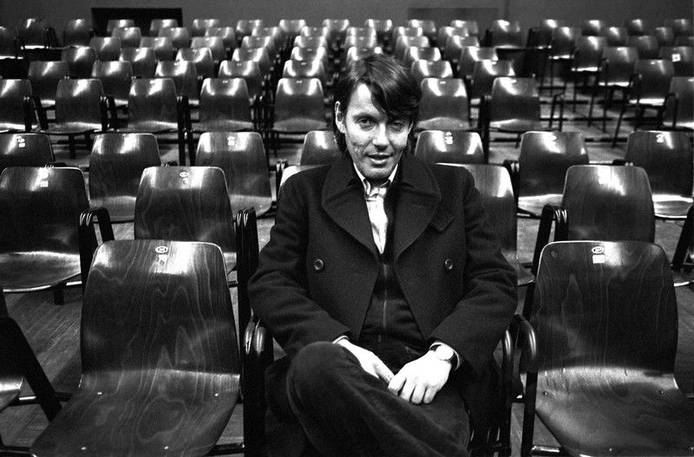


Crêuza de mä (Muletrack by the sea) came into the world three decades ago.
Tell me about it, how was it born?
"Thirty years! They flew by…I would have sworn no more than twenty had passed… even fewer, perhaps! Crêuza de mä was, first and foremost, a courageous work, the offspring of a very fruitful collaboration between Fabrizio De André [2] and I.
Fabrizio was known for his uncanny ability to write perfect, elegant verses in Italian, and there we were, recording songs in a Genoese dialect that wasn’t understood well even in that city! At the time I had been working with Fabrizio for about three years, since 1981, on the record Indiano while also compulsively working for years on a lot of Mediterranean material on my own, researching the roots of that music. Once in a while I would have him listen to it to get his feedback. I never thought we would do something with it together. It was unthinkable to sing the Mediterranean material in Italian.
But Fabrizio had just done two ballad-style, American-inspired records, Rimini and Indiano, and was ready to plunge into something new. So we decided to do this record. At first we thought about ‘inventing’ a language that could have been that of a sailor who speaks Portuguese, French, Indian, and Arabic, until Fabrizio came up with the idea to do it in Genoese instead. That alone magically fixed everything. He started writing stories about the Genoa Republic and about sailors, as well as political songs like Sidún (Sidon, Lebanon), which denounced Israel’s ongoing attacks (1975-1991) on the civilian population, especially on the many Palestinian refugees."
How is this remix different from the original? Did you change a lot of things? Why should one buy the new version?
"Going back into the recording studio after thirty years has meant reworking Crêuza de mä both from a stylistic and technical standpoint. When we recorded it originally we did it on analog tape, at a time when the analog system was at the peak of its development. Digital, on the contrary, was in its infancy, thus some frequencies and harmonics in the mix were lost and the sound was a bit weak.
Yet I remembered brilliant and full-bodied sounds from the original analog recordings, so I asked for the analog tape to be sent to me and, armed with the patience of a monk, I mixed each track as faithfully to the original as possible, keeping the same frequencies and sound, and respecting the original artistic choices as well: the entrance of instruments and the order of most of the tracks.
In some, however, I have reordered the instruments and modified the arrangement. But I only used the existing elements. I also remixed three of the tracks, Crêuza de mä, Â duménega, and Sinàn Capudàn Pascià, to give them a more modern sensibility.
Lastly, I remembered that there was a different version of the song Jamin-a, and I added that to the final mix too. So we have both songs on the remix."
What did this record mean to the music world when it came out?
"The album was way ahead of its time; we recorded it in ‘83 and released it in 1984. Peter Gabriel’s Real World label [3] wasn’t founded until five years later, in 1989. Italy was very cutting edge in the 70s, with groups like Nuova Compagnia di Canto Popolare, Canzoniere del Lazio, Area, Napoli Centrale, and artists like Pino Daniele. It was really because of the Italian record industry’s shortsightedness that Italy failed to take the lead in world music.
When we came out with Crêuza de mä in 1984, the album was isolated in a world where Glam Rock was triumphing – Duran Duran, Spandau Ballet – and it took a while for it to be noticed. But once it did, the record has never been forgotten. It has been honored with every possible award from music critics. To date it has been considered one of the best 100 albums of all time in the history of Italian music. I think it is ranked number 4.
At the end of the 80s David Byrne, along with other American artists, was interviewed by Rolling Stone and he was asked to name the 10 most important world albums of that decade, and he mentioned Crêuza de mä among them."
What has it been like to work on Crêuza de mä again after all these years?
"Doing the remake was quite engaging: listening to the songs one by one, finding hidden musical phrases among the scraps of paper and notes to self leftover from so long ago. It has been a strange journey back in time…Crêuza de mä is maybe the most important thing I have done in my career. But I am naturally inclined to look forward, to the future. The most exciting step for me is the one I am about to take."
-----
Mauro Pagani [4] is a musician, a composer, a violinist and one of the founding members of the progressive rock band Premiata Forneria Marconi [5] in the 1970s. A leading voice in the Italian music panorama, he has directed the Festival of Sanremo in 2013 and 2014. He has won numerous prizes for his movie soundtracks and is also a fiction writer, currently working on his second novel.
Tiziana Rinaldi Castro [6] lives in Brooklyn. She is a novelist, poet, and editorialist from Italy. She teaches Ancient Greek Literature at Montclair State University.
Source URL: http://ftp.iitaly.org/magazine/focus/art-culture/article/creuza-de-ma-mediterranean-experiment-30-years-later
Links
[1] http://ftp.iitaly.org/files/38336fabriziodeandre1404416268jpg
[2] http://en.wikipedia.org/wiki/Fabrizio_De_Andr%C3%A9
[3] https://realworldrecords.com/world-music/
[4] http://en.wikipedia.org/wiki/Mauro_Pagani
[5] http://www.pfmpfm.it/eng/
[6] http://www.tizianarinaldicastro.com/tiziana_rinaldi_castro/who,_me.html